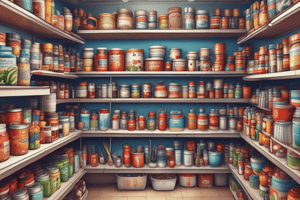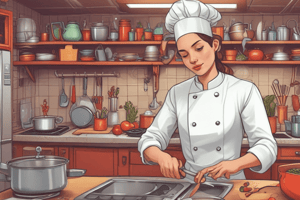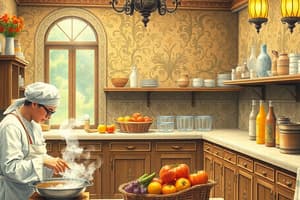Podcast
Questions and Answers
What was one of the earliest wood-burning kitchen stoves developed in 1735?
What was one of the earliest wood-burning kitchen stoves developed in 1735?
- Masonry Stove
- Metal Cauldron
- Open Fire
- Stew Stove or Castrol Stove (correct)
Wearing heavy makeup and long manicured nails is acceptable in a kitchen laboratory.
Wearing heavy makeup and long manicured nails is acceptable in a kitchen laboratory.
False (B)
Besides providing food, what other functions did early cooking areas serve?
Besides providing food, what other functions did early cooking areas serve?
heat, light, and safety
Using color-coded chopping boards prevents _________.
Using color-coded chopping boards prevents _________.
Match the following items with their proper color coding:
Match the following items with their proper color coding:
What is the primary focus of culinary arts?
What is the primary focus of culinary arts?
Learning to cook is unlike learning to drive a car.
Learning to cook is unlike learning to drive a car.
Besides chefs or cooks, what other general terms can be used to describe someone working in the culinary field?
Besides chefs or cooks, what other general terms can be used to describe someone working in the culinary field?
A kitchen is a functional area in a home where food is prepared and ______.
A kitchen is a functional area in a home where food is prepared and ______.
Which of the following best describes a kitchen?
Which of the following best describes a kitchen?
Match the following terms with their descriptions:
Match the following terms with their descriptions:
A kitchen's importance is limited to its function as a place to cook.
A kitchen's importance is limited to its function as a place to cook.
Why is it essential to study the fundamentals of culinary arts?
Why is it essential to study the fundamentals of culinary arts?
What color is the trash bin designated for food waste?
What color is the trash bin designated for food waste?
A red chopping board should be used for bread and dairy products.
A red chopping board should be used for bread and dairy products.
What piece of chef's attire is designed to withstand heat, spills, and rigorous demands?
What piece of chef's attire is designed to withstand heat, spills, and rigorous demands?
The white color of a toque was chosen to symbolize ______ and hygiene.
The white color of a toque was chosen to symbolize ______ and hygiene.
Match the colored chopping boards with their appropriate uses:
Match the colored chopping boards with their appropriate uses:
What is one of the benefits of wearing clog shoes in the kitchen?
What is one of the benefits of wearing clog shoes in the kitchen?
The food industry is a small industry and does not impact the global economy.
The food industry is a small industry and does not impact the global economy.
List two processes that the food industry includes
List two processes that the food industry includes
What is the estimated annual revenue generated by the food industry in the country mentioned?
What is the estimated annual revenue generated by the food industry in the country mentioned?
Customer satisfaction is not a primary objective of the food industry.
Customer satisfaction is not a primary objective of the food industry.
What is the name of the management system that addresses food safety by analyzing and controlling hazards?
What is the name of the management system that addresses food safety by analyzing and controlling hazards?
Food products must be transported in a manner that prevents physical, chemical, and ___________ contamination.
Food products must be transported in a manner that prevents physical, chemical, and ___________ contamination.
How often should food industry staff undergo a medical examination?
How often should food industry staff undergo a medical examination?
Match the following food industry areas with their respective activities:
Match the following food industry areas with their respective activities:
Food additives are only used to modify the appearance of food.
Food additives are only used to modify the appearance of food.
What does TACT stand for in the context of cleaning and disinfection in the food industry?
What does TACT stand for in the context of cleaning and disinfection in the food industry?
Which of the following is NOT typically a health risk associated with industrial preservatives?
Which of the following is NOT typically a health risk associated with industrial preservatives?
Food chemistry only studies biological food components.
Food chemistry only studies biological food components.
What is the primary purpose of the kitchen brigade system?
What is the primary purpose of the kitchen brigade system?
The kitchen brigade system was influenced by Escoffier's experience in the French _____.
The kitchen brigade system was influenced by Escoffier's experience in the French _____.
Match the following food safety concepts with their descriptions:
Match the following food safety concepts with their descriptions:
What is the main practical application of food chemistry within the food industry?
What is the main practical application of food chemistry within the food industry?
The primary objective of the food safety law is to reduce consumer information about food and feed products.
The primary objective of the food safety law is to reduce consumer information about food and feed products.
Who introduced the Brigada de Cuisine (Kitchen Brigade System)?
Who introduced the Brigada de Cuisine (Kitchen Brigade System)?
Flashcards
Value of Kitchen
Value of Kitchen
A well-maintained kitchen adds property value and enhances living.
Origin of Kitchen
Origin of Kitchen
Kitchens began with open fires, evolving through history for cooking.
Development of Oven
Development of Oven
The design of ovens evolved due to economics and technology changes.
Kitchen Uniform Rules
Kitchen Uniform Rules
Signup and view all the flashcards
Waste Segregation
Waste Segregation
Signup and view all the flashcards
Green Trash Bin
Green Trash Bin
Signup and view all the flashcards
Blue Trash Bin
Blue Trash Bin
Signup and view all the flashcards
Gray Trash Bin
Gray Trash Bin
Signup and view all the flashcards
Green Chopping Board
Green Chopping Board
Signup and view all the flashcards
Yellow Chopping Board
Yellow Chopping Board
Signup and view all the flashcards
Toque
Toque
Signup and view all the flashcards
Chef's Jacket
Chef's Jacket
Signup and view all the flashcards
Food Industry
Food Industry
Signup and view all the flashcards
Culinary Arts
Culinary Arts
Signup and view all the flashcards
Chef
Chef
Signup and view all the flashcards
Kitchen
Kitchen
Signup and view all the flashcards
Functional Kitchen
Functional Kitchen
Signup and view all the flashcards
Social Space
Social Space
Signup and view all the flashcards
Cooking Appliances
Cooking Appliances
Signup and view all the flashcards
Healthy Eating Habits
Healthy Eating Habits
Signup and view all the flashcards
Creativity in Cooking
Creativity in Cooking
Signup and view all the flashcards
Food Industry Importance
Food Industry Importance
Signup and view all the flashcards
Main Objectives of Food Industry
Main Objectives of Food Industry
Signup and view all the flashcards
HACCP System
HACCP System
Signup and view all the flashcards
Staff Hygiene
Staff Hygiene
Signup and view all the flashcards
Transport Hygiene
Transport Hygiene
Signup and view all the flashcards
Cleaning and Disinfection
Cleaning and Disinfection
Signup and view all the flashcards
Food Chemistry
Food Chemistry
Signup and view all the flashcards
Food Additives
Food Additives
Signup and view all the flashcards
Preservatives
Preservatives
Signup and view all the flashcards
Health Risks of Preservatives
Health Risks of Preservatives
Signup and view all the flashcards
Objectives of Food Safety Law
Objectives of Food Safety Law
Signup and view all the flashcards
Kitchen Organization
Kitchen Organization
Signup and view all the flashcards
Brigade de Cuisine System
Brigade de Cuisine System
Signup and view all the flashcards
George Auguste Escoffier
George Auguste Escoffier
Signup and view all the flashcards
Kitchen Task Allocation
Kitchen Task Allocation
Signup and view all the flashcards
Study Notes
Module 1: Kitchen Essentials and Basic Food Preparation
- Culinary arts involve food preparation, cooking, and presentation.
- Chefs and cooks work in establishments like restaurants.
- Learning to cook is like learning to drive; practice improves skill.
- Culinary skills form the foundation for a career in the food industry.
- The kitchen is a dynamic environment requiring proper equipment and tools.
Introduction
- Culinary arts are related to cooking, food preparation, and presentation.
- People working in the food industry are commonly called chefs or cooks.
- Learning to cook is similar to learning to drive a car, by practice and studying fundamentals of culinary arts
- The kitchen is a place to showcase creativity in culinary skills.
- Kitchens are crucial in people's daily life providing meals
Kitchen Tools and Equipment
- This section details various kitchen tools and equipment.
Kitchen Laboratory Wear Proper Uniform
- Wear chef's uniform: jacket, pants, apron
- Hairnet and toque/bull cap for girls to tie their hair
- Wear white color apron
- Wear black socks and clog shoes
- Clean short nails, no manicure
- Wear light makeup or no makeup
Segregate Food and Non-Food Waste
- Food waste and non-food waste must be segregated.
- This aids in the recycling, reuse, and recovery of waste.
Things to Bring
- 3 white towels
- 2 colored towels
- Sponge
- Liquid detergent
Strictly Observe the Usage of Color-Coded Chopping Boards
- Color-coded chopping boards prevent cross-contamination.
Color-Coded Trash Bins
- Green trash bin for food waste
- Blue trash bin for paper/cardboard
- Gray trash bin for glass/plastic/metal waste
Color-Coded Chopping Boards
- Green board for salads, fruits, and vegetables
- Yellow board for raw poultry
- Blue board for fish and seafoods
- White board for breads and dairy products
- Brown/tan board for cooked meat
- Red board for raw meat
Safe Food Handling
- Clean sanitized food-grade gloves are essential for kitchen safety.
Safe Food Handling Principles
- Using Clean sanitized food-grade gloves is important for food safety.
Proper Uniform
- Proper uniform is crucial for cleanliness.
PPE (Personal Protective Equipment)
- PPE is essential for safety and hygiene.
Toque
- The toque (tall hat) is worn by professional chefs for hygiene.
- White color stands for cleanliness and hygiene.
- Pleats in the hat may represent the number of egg recipes a chef has mastered.
Chef's Jacket
- Chef's Jacket is an important part of the uniform
- It is designed to withstand heat, spills, and demands.
- It must maintain professional look.
Chef's Apron
- A chef's apron is white-colored.
- It's essential for keeping the kitchen clean and organized
Chef's Pants
- Chef's Pants are black-colored.
Clog Shoes
- Clogs give better posture, straight up.
- They are comfortable.
- They offer protection against falling and hot objects in the kitchen .
Module 2: Food Industry
- Food Industry deals with aspects of food from preparation to consumption.
- It includes processing, preserving, distributing, and serving food and beverages.
Introduction
- This section contains an introduction to food industry
Food Industry Definition
- The food industry involves the production, processing, preparing, serving, and distribution of food and beverages.
Place of Food Industry
- The food industry is one of the biggest world industries.
- It employs 15,600 people worldwide.
- It produces 115 billion dollars annually
Importance of the Food Industry
- The food industry focuses on customer satisfaction.
- It ensures food safety.
- It provides product information
- It maintains commercial viability for products
HACCP (Hazard Analysis and Critical Control Points)
- HACCP is a food safety management system to analyze and control hazards.
- It covers raw material production, procurement, handling, manufacturing, distribution, and consumption.
Hygiene rules for Agri-food Industry
- Proper staff hygiene
- Hygiene during transport and storage of products
- Hygiene during cleaning and disinfection of tools, equipment, or premises
- Pest controls and waste management procedures
Food Industry and Chemistry
- Food chemistry is important in the food industry.
- It deals with the chemical interactions in food and how food is prepared.
- It's crucial in understanding chemical reactions and developing new products.
Preservatives and Health Risks
- Preservatives extend food shelf life, but may pose health risks.
Objectives of Food Safety Law
- Establish the general principles for food safety.
- Determine conditions under which foods can be marketed as safe.
- Provide general requirements for safe products..
- Indicate mandatory consumer rules about labeling and documents.
Purpose of Kitchen Organization
- Kitchen organization assigns tasks, ensures efficiency, and clarifies each worker's responsibilities.
Kitchen Brigade System
- A kitchen brigade system is a hierarchical structure found in hotels and large restaurants.
- Its purpose is to organize kitchen staff and roles clearly.
Kitchen Brigade System Roles
- This section details the roles within a kitchen brigade such as:
- Executive Chef
- Sous Chef
- Chef de Partie
- Other roles, including Tournant, Saucier, Rotisseur, Grillardin, Poissonnier, Poulet, Entremetier, Legumier, Potager, Pâtissier, Demi-chef, Commis, Expediter/Abouyeur, Garde-Manger
Personal Hygiene (Food Safety)
- List of rules for personal hygiene in food industry. A general summary is provided.
Studying That Suits You
Use AI to generate personalized quizzes and flashcards to suit your learning preferences.



